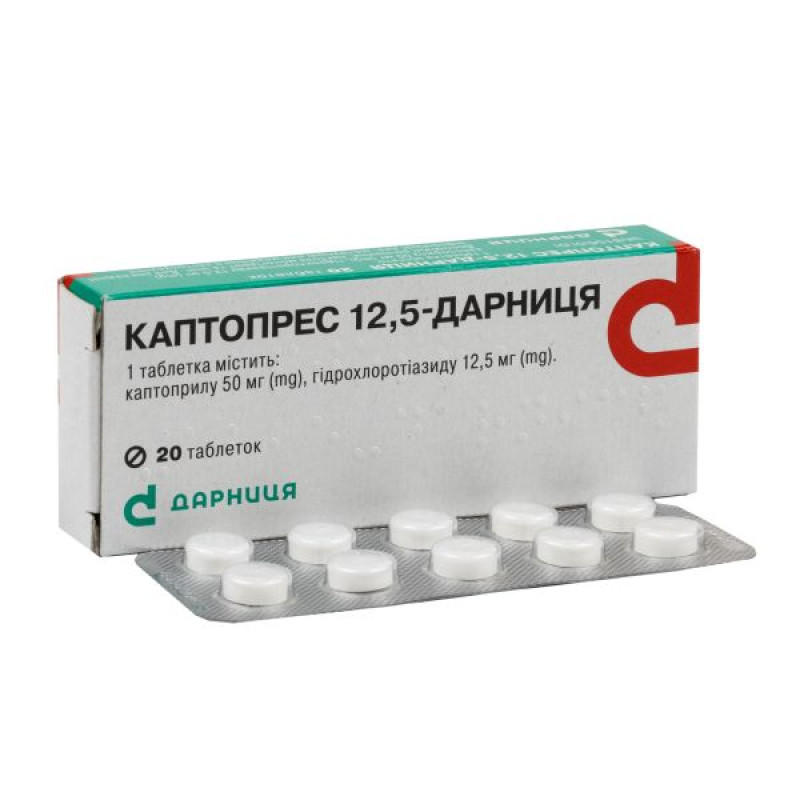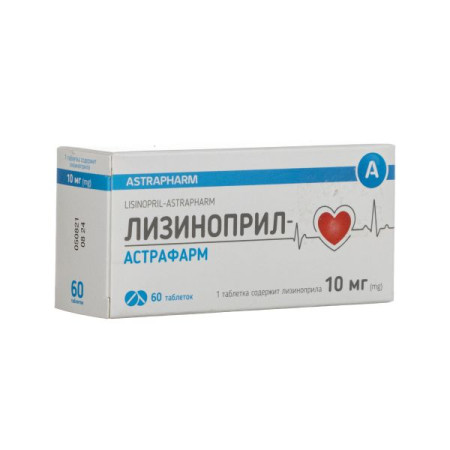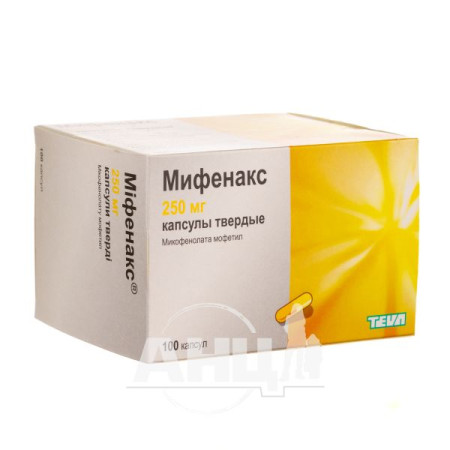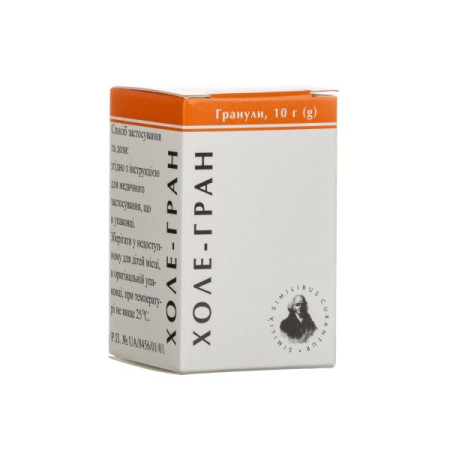Kaptopres 12.5-Darnitsa tablets No. 20
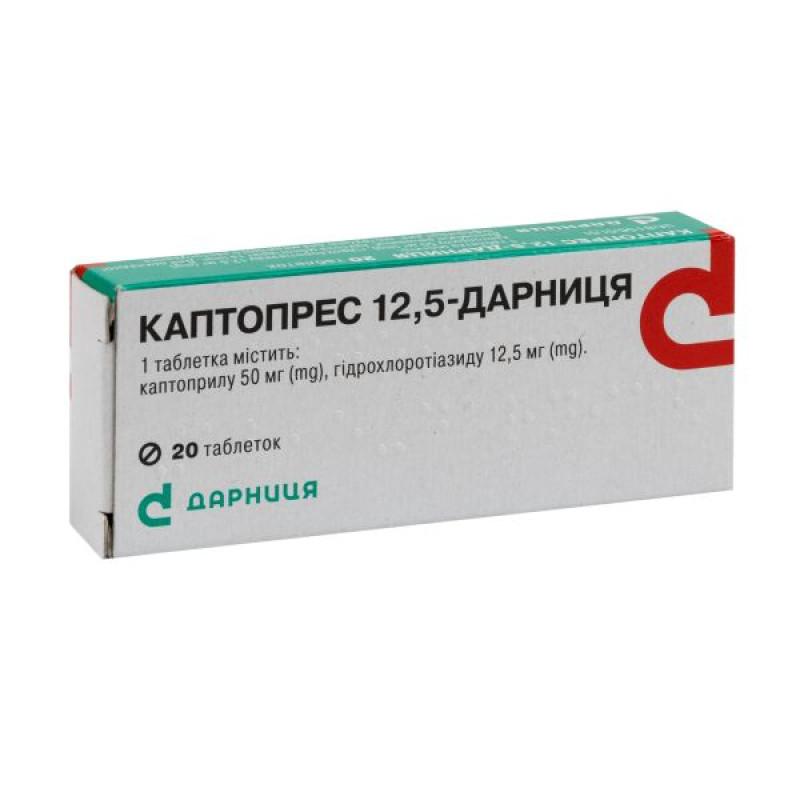
Instructions for Kaptopres 12.5-Darnitsa tablets No. 20
Composition
active ingredients: captopril, hydrochlorothiazide;
1 tablet contains: captopril 50 mg, hydrochlorothiazide 12.5 mg;
Excipients: microcrystalline cellulose, lactose monohydrate, colloidal anhydrous silicon dioxide, potato starch, stearic acid.
Dosage form
Pills.
Main physicochemical properties: white tablets, flat-cylindrical in shape, with a bevel and a score, with a specific odor.
Pharmacotherapeutic group
Combined ACE inhibitor preparations. Captopril and diuretics. ATC code C09B A01.
Pharmacological properties
Pharmacodynamics
Captopres 12.5-Darnitsa is a combined antihypertensive drug containing a dosed combination of captopril and hydrochlorothiazide.
Captopril is an angiotensin-converting enzyme (ACE) inhibitor. It inhibits the formation of angiotensin II, preventing its vasoconstrictor action and stimulating effect on the secretion of aldosterone in the adrenal glands. It reduces total peripheral vascular resistance, blood pressure, reduces preload on the myocardium, and reduces pressure in the right atrium and the pulmonary circulation.
Hydrochlorothiazide causes a moderately pronounced diuretic effect, increasing the excretion of sodium, chlorine, potassium and water ions from the body. Reduces the content of sodium ions in the vascular wall, reducing its sensitivity to vasoconstrictor effects and thereby enhancing the antihypertensive effect of captopril.
Pharmacokinetics
Captopril is actively absorbed in the digestive tract when taken orally. The time to reach maximum plasma concentration is approximately 1 hour. 25-30% of captopril is bound to plasma proteins. Metabolized in the liver. The main metabolites are captopril-cysteine, a disulfide dimer of captopril. The half-life (T½) is approximately 2-3 hours. 95% of captopril is excreted by the kidneys: 50% as metabolites, up to 50% unchanged.
Hydrochlorothiazide is absorbed from the gastrointestinal tract by 68-78% when administered orally. The elimination half-life (T½) is approximately 3-4 hours. 20-75% of hydrochlorothiazide is excreted unchanged by the kidneys.
In patients with renal insufficiency, the elimination of the drug is slowed down.
Indication
Arterial hypertension.
Contraindication
Hypersensitivity to captopril, other ACE inhibitors, hydrochlorothiazide, other sulfonamide-derived drugs, or to any of the excipients; history of angioedema during treatment with other ACE inhibitors; congenital (idiopathic) angioedema; severe renal dysfunction (plasma creatinine concentration more than 1.8 mg/100 ml or creatinine clearance less than 30 ml/min), severe renal failure; bilateral renal artery stenosis or stenosis of the artery to a solitary kidney with progressive azotemia; kidney transplantation; anuria; aortic stenosis and other obstructive disorders that impede the outflow of blood from the left ventricle; hypertrophic cardiomyopathy with low cardiac output; Severe liver dysfunction (precomatose state, hepatic coma, hepatic failure); primary hyperaldosteronism; porphyria; hypokalemia, hyperkalemia, hyponatremia in hypovolemia, hypercalcemia, gout; pregnant women or women planning to become pregnant (see "Use during pregnancy or breastfeeding").
Interaction with other medicinal products and other types of interactions
Instructions for Kaptopres 12.5-Darnitsa tablets No. 20
Composition
active ingredients: captopril, hydrochlorothiazide;
1 tablet contains: captopril 50 mg, hydrochlorothiazide 12.5 mg;
Excipients: microcrystalline cellulose, lactose monohydrate, colloidal anhydrous silicon dioxide, potato starch, stearic acid.
Dosage form
Pills.
Main physicochemical properties: white tablets, flat-cylindrical in shape, with a bevel and a score, with a specific odor.
Pharmacotherapeutic group
Combined ACE inhibitor preparations. Captopril and diuretics. ATC code C09B A01.
Pharmacological properties
Pharmacodynamics
Captopres 12.5-Darnitsa is a combined antihypertensive drug containing a dosed combination of captopril and hydrochlorothiazide.
Captopril is an angiotensin-converting enzyme (ACE) inhibitor. It inhibits the formation of angiotensin II, preventing its vasoconstrictor action and stimulating effect on the secretion of aldosterone in the adrenal glands. It reduces total peripheral vascular resistance, blood pressure, reduces preload on the myocardium, and reduces pressure in the right atrium and the pulmonary circulation.
Hydrochlorothiazide causes a moderately pronounced diuretic effect, increasing the excretion of sodium, chlorine, potassium and water ions from the body. Reduces the content of sodium ions in the vascular wall, reducing its sensitivity to vasoconstrictor effects and thereby enhancing the antihypertensive effect of captopril.
Pharmacokinetics
Captopril is actively absorbed in the digestive tract when taken orally. The time to reach maximum plasma concentration is approximately 1 hour. 25-30% of captopril is bound to plasma proteins. Metabolized in the liver. The main metabolites are captopril-cysteine, a disulfide dimer of captopril. The half-life (T½) is approximately 2-3 hours. 95% of captopril is excreted by the kidneys: 50% as metabolites, up to 50% unchanged.
Hydrochlorothiazide is absorbed from the gastrointestinal tract by 68-78% when administered orally. The elimination half-life (T½) is approximately 3-4 hours. 20-75% of hydrochlorothiazide is excreted unchanged by the kidneys.
In patients with renal insufficiency, the elimination of the drug is slowed down.
Indication
Arterial hypertension.
Contraindication
Hypersensitivity to captopril, other ACE inhibitors, hydrochlorothiazide, other sulfonamide-derived drugs, or to any of the excipients; history of angioedema during treatment with other ACE inhibitors; congenital (idiopathic) angioedema; severe renal dysfunction (plasma creatinine concentration more than 1.8 mg/100 ml or creatinine clearance less than 30 ml/min), severe renal failure; bilateral renal artery stenosis or stenosis of the artery to a solitary kidney with progressive azotemia; kidney transplantation; anuria; aortic stenosis and other obstructive disorders that impede the outflow of blood from the left ventricle; hypertrophic cardiomyopathy with low cardiac output; Severe liver dysfunction (precomatose state, hepatic coma, hepatic failure); primary hyperaldosteronism; porphyria; hypokalemia, hyperkalemia, hyponatremia in hypovolemia, hypercalcemia, gout; pregnant women or women planning to become pregnant (see "Use during pregnancy or breastfeeding").
Interaction with other medicinal products and other types of interactions
Cytotoxic agents (e.g. cyclophosphamide, methotrexate). Thiazides may reduce the renal excretion of cytotoxic drugs and potentiate their myelosuppressive effect.
Anticholinergics (e.g. atropine, biperiden): Due to decreased gastrointestinal motility and decreased gastric emptying rate, the bioavailability of thiazide-type diuretics increases.
Cyclosporine: Concomitant use of cyclosporine may exacerbate hyperuricemia and increase the risk of complications such as gout.
Amantadine: Thiazides, including hydrochlorothiazide, may increase the risk of side effects caused by amantadine.
Nonsteroidal anti-inflammatory drugs (NSAIDs), including selective cyclooxygenase-2 (COX-2) inhibitors, acetylsalicylic acid >3 g/day and non-selective NSAIDs. NSAIDs may reduce the antihypertensive effect of hydrochlorothiazide and increase the effect of hydrochlorothiazide on serum potassium when administered concomitantly.
Medicinal products affected by changes in serum potassium: Periodic monitoring of serum potassium and ECG is recommended when hydrochlorothiazide is administered concomitantly with medicinal products affected by changes in serum potassium (e.g. digitalis glycosides and antiarrhythmic medicinal products) and medicinal products known to induce torsades de pointes (including some antiarrhythmic medicinal products), as hypokalaemia is a predisposing factor to torsades de pointes.
Clinical trial data have shown that dual blockade of the renin-angiotensin-aldosterone system (RAAS) through the combined use of ACE inhibitors, angiotensin II receptor blockers or aliskiren is associated with a higher incidence of adverse reactions such as hypotension, hyperkalemia and decreased renal function (including acute renal failure) compared with the use of RAAS-acting agents alone.
The use of the drug may lead to a positive result in a urine test for acetone.
The drug can be used for the treatment of acute myocardial infarction in combination with acetylsalicylic acid (cardiological doses), thrombolytic agents, β-blockers and/or nitrates.
Application features
Before starting treatment with the drug, diuretics should be reduced or completely discontinued.
Before prescribing ACE inhibitors, the circulating blood volume (CVV) should be corrected, and the issue of prescribing the lowest effective optimal dose of the drug should be addressed.
During the use of the drug, the level of electrolytes (in particular potassium), the content of urea and creatinine in blood plasma, and the picture of peripheral blood should be periodically determined.
A low-sodium diet is recommended while using the drug.
It is not recommended to drink alcoholic beverages while using the medicine.
The drug should be used with caution in patients with impaired water and electrolyte balance (due to intensive diuretic therapy, diarrhea, vomiting, low-sodium diet) and in patients on hemodialysis, as the development of arterial hypotension is possible. Before using the drug, correction of water and electrolyte balance should be performed.
The drug should be used with caution in patients with severe cardiac disorders, in elderly patients (over 65 years of age). The drug should be prescribed to this category of patients only under careful monitoring of blood pressure, kidney function, and the state of water and electrolyte metabolism.
In case of hypotension, the patient should be placed in a horizontal position (on his back), and if necessary, increase the BCC by administering 0.9% sodium chloride solution.
Features of use related to the presence of hydrochlorothiazide in the composition of the drug.
As with other antihypertensive drugs, symptomatic hypotension may occur in some patients.
Thiazide therapy may reduce glucose tolerance. It may be necessary to modify the doses of antidiabetic agents, including insulin. Latent diabetes mellitus may manifest during thiazide therapy.
Thiazides may reduce renal calcium excretion and may also cause a small, transient increase in serum calcium. Significant hypercalcemia may be a manifestation of latent hyperparathyroidism.
Hypersensitivity reactions may occur in patients receiving thiazides, especially in patients with a history of allergy or bronchial asthma, and in patients without previous history of these diseases. There have been reports of exacerbation or activation of systemic lupus erythematosus while taking thiazides.
The medicine may affect the results of the following laboratory tests:
The drug should be used with caution in cases of impaired liver function or progressive liver disease, since thiazide diuretics can cause disturbances in water and electrolyte balance, which can lead to the rapid development of hepatic coma. The drug should be prescribed to this category of patients only under careful monitoring of blood pressure, kidney function, and water and electrolyte metabolism.
The drug should be used with caution in cases of impaired renal function, since thiazide diuretics can cause azotemia. Cumulation of the drug is also possible. In the case of progression of kidney diseases characterized by an increase in the level of residual blood nitrogen, the feasibility of continuing therapy should be carefully assessed and, if necessary, treatment should be discontinued.
The hypotensive effect of hydrochlorothiazide may be enhanced after sympathectomy.
In patients taking hydrochlorothiazide, exacerbation of gout due to increased uric acid concentration, clinical detection of latent diabetes mellitus, exacerbation of systemic lupus erythematosus is possible.
Photosensitivity reactions have been reported during treatment with thiazide diuretics. If photosensitivity reactions occur during use of the drug, it is recommended to discontinue the drug. If the doctor considers it necessary to re-prescribe the diuretic, it is recommended to protect areas of the body exposed to sunlight or artificial UV radiation.
Hydrochlorothiazide may cause water and electrolyte imbalance (hypokalemia, hyponatremia and hypochloraemic alkalosis). Symptoms: dry mouth, thirst, weakness, lethargy, drowsiness, restlessness, muscle pain or cramps, muscular weakness, arterial hypotension, oliguria, tachycardia and gastrointestinal disorders such as nausea and vomiting. Although concomitant use with captopril reduces the risk of developing hypokalemia caused by hydrochlorothiazide, patients with cirrhosis of the liver, increased diuresis, insufficient oral replacement of electrolyte losses, as well as individuals receiving therapy with glucocorticosteroids or adrenocorticotropic hormone may develop hyponatremia in hot weather in patients prone to edema, usually mild and not requiring treatment.
Hydrochlorothiazide may cause hypercalcemia. Therefore, the drug should be discontinued before determining parathyroid function.
Hydrochlorothiazide may increase cholesterol and triglyceride levels, and decrease blood levels of magnesium and iodine-binding thyroglobulin (without signs of thyroid dysfunction).
Hydrochlorothiazide may cause a positive doping test.
Features of use related to the presence of captopril in the composition of the drug.
The drug should be used with caution in patients with impaired renal function (creatinine clearance less than 40 ml/min). Initial doses of captopril should be prescribed in accordance with creatinine clearance, and subsequently depending on the patient's response to treatment. Regular monitoring of renal function indicators should be carried out (at the beginning and periodically during treatment): determine the level of potassium and creatinine in the blood plasma.
The drug should be used with caution in patients with uncomplicated arterial hypertension, since in some cases symptomatic arterial hypotension may develop. The likelihood of its development increases in patients with impaired water and electrolyte balance (due to intensive diuretic therapy, diarrhea, vomiting, low-sodium diet) and patients on hemodialysis. Symptomatic hypotension has also been observed in patients with heart failure. Treatment of such patients should be started under the supervision of a physician with low doses, while carefully selecting the doses. This also applies to patients with ischemic heart disease or cerebrovascular disease, in whom a significant decrease in blood pressure can lead to myocardial infarction or cerebrovascular accident (stroke).
Captopril should be avoided in the event of cardiogenic shock and significant hemodynamic disturbances.
The drug should be used with caution in patients with renovascular hypertension, since concomitant use with ACE inhibitors increases the risk of severe arterial hypotension and renal failure. Treatment of such patients should be initiated under medical supervision, with low doses, and with careful dose titration.
The combined use of ACE inhibitors, angiotensin II receptor blockers or aliskiren is clearly associated with an increased risk of hypotension, hyperkalaemia and decreased renal function (including acute renal failure). Therefore, dual blockade of the renin-angiotensin-aldosterone system (RAAS) through the combined use of ACE inhibitors, angiotensin II receptor blockers or aliskiren is not recommended.
If dual blockade therapy is absolutely necessary, it should be carried out under medical supervision with frequent checks of renal function, electrolytes and blood pressure.
The drug should be used with caution in diabetic patients taking oral antidiabetic agents or insulin, and blood glucose levels should be monitored regularly, especially during the first month of treatment.
Very rarely, ACE inhibitors have been associated with a syndrome that begins with cholestatic jaundice and progresses rapidly to hepatic necrosis and (sometimes) death. The mechanism of this syndrome is not known. Patients receiving ACE inhibitors who develop jaundice or marked elevations of liver enzymes should discontinue ACE inhibitors and consult a physician.
In patients, especially those taking relatively high doses of captopril (more than 150 mg/day) or with impaired renal function, proteinuria may develop. Proteinuria of more than 1 g/day has been reported in approximately 0.7% of patients treated with captopril. Nephrotic syndrome has been diagnosed in 20% of patients with proteinuria. In most cases, proteinuria resolved within 6 months after discontinuation of the drug. Renal function parameters such as blood urea nitrogen and creatinine rarely changed. In patients with impaired renal function, proteinuria should be determined before treatment and periodically monitored during drug therapy.
Neutropenia, agranulocytosis, thrombocytopenia and anemia have been reported in patients taking ACE inhibitors. Neutropenia is rare in patients with normal renal function in the absence of other factors. The drug should be administered with extreme caution to patients with collagen diseases, patients receiving immunosuppressants, taking allopurinol or procainamide, and in combination with these conditions, especially against the background of existing renal dysfunction. Some such patients develop severe infections that do not always respond to intensive antibiotic therapy. When using the drug in such patients, periodic monitoring of the number of leukocytes in the blood and their differential count should be carried out (before treatment, every 2 weeks during the first three months of therapy and periodically thereafter) and the patient should be warned about the need to report any signs of infection (fever, enlarged lymph nodes, sore throat). If neutropenia occurs (neutrophil count < 1000/mm3), the drug should be discontinued. After discontinuation of therapy, the neutrophil count rapidly returns to normal in most patients.
Some patients taking ACE inhibitors, including captopril, have experienced increases in serum potassium. Patients at risk for hyperkalemia include patients with renal insufficiency, diabetes mellitus, those taking potassium-sparing diuretics, potassium supplements, and those taking other medicinal products that increase serum potassium. If the use of these medicinal products during treatment with ACE inhibitors is deemed necessary, serum potassium levels should be monitored regularly.
Angioedema of the face, extremities, lips, tongue, glottis and larynx has been reported in some patients receiving ACE inhibitors, especially during the first weeks of treatment. In some cases, angioedema may develop even after prolonged treatment with ACE inhibitors. Isolated fatalities have been reported due to angioedema of the larynx or tongue. If edema develops, captopril should be discontinued immediately and appropriate treatment should be initiated. The patient should be hospitalized and observed for at least 12-24 hours until symptoms resolve. Black patients are at increased risk of developing angioedema.
In patients undergoing surgery or anesthesia with drugs that lower blood pressure, captopril may block the increase in angiotensin II formation under the influence of compensatory renin release. Hypotension resulting from this mechanism should be corrected by the introduction of additional fluid volume.
During the use of ACE inhibitors, patients may develop a persistent non-productive cough that disappears after discontinuation of treatment.
Patients taking ACE inhibitors during desensitization with hymenoptera venom may develop persistent anaphylactoid reactions. These reactions can be avoided by temporarily stopping ACE inhibitors.
Patients receiving ACE inhibitors during hemodialysis using high-flux membranes may develop persistent anaphylactoid reactions. These reactions can be avoided by changing the dialysis membrane to a different type of membrane or by using a different class of antihypertensive agent.
Patients taking ACE inhibitors may develop persistent anaphylactoid reactions during LDL apheresis. These reactions can be avoided by
temporary discontinuation of ACE inhibitors before each apheresis.
The use of ACE inhibitors, including captopril, in patients of the Negroid race is less effective in lowering blood pressure than in patients of other races, due to the predominance of low-renin fractions.
Concomitant use of the drug with lithium is not recommended due to increased toxicity of the latter.
The medicine contains lactose, therefore patients with rare hereditary forms of galactose intolerance, lactase deficiency or glucose-galactose malabsorption syndrome should not take the medicine.
Ability to influence reaction speed when driving vehicles or other mechanisms
When using the drug, you should refrain from driving vehicles or working with other mechanisms; dizziness and drowsiness are possible, especially at the beginning of therapy.
Use during pregnancy or breastfeeding
The drug is contraindicated for use in pregnant women or women planning to become pregnant. If pregnancy is confirmed during treatment with the drug, its use should be immediately discontinued and replaced with another drug approved for use in pregnant women.
The medicine should not be used during breastfeeding.
Method of administration and doses
The drug is taken orally 1 hour before meals, as the absorption of the drug is reduced if food is present in the stomach.
The dose of the drug is set by the doctor individually, depending on the clinical picture of the disease.
The initial dose may be ½ tablet (25 mg captopril and 6.25 mg hydrochlorothiazide) once a day.
In the future, if necessary, the maintenance dose can be increased to 1 tablet (50 mg of captopril and 12.5 mg of hydrochlorothiazide) once a day.
The maximum therapeutic effect occurs 6-8 weeks after the start of treatment. Dose adjustment should be carried out at 6-week intervals, unless clinical manifestations require a more rapid change in dosage. If blood pressure is insufficiently reduced, captopril and hydrochlorothiazide can be additionally included in the treatment regimen as monodrugs. In this case, the daily dose of captopril should not exceed 150 mg, hydrochlorothiazide - 50 mg.
Patients with impaired renal function.
Since captopril and hydrochlorothiazide are excreted from the body mainly by the kidneys, the level of the drugs may increase if their function is impaired. It is recommended to reduce the dose of the drug: with creatinine clearance from 30 to 80 ml/min, the initial dose is ½ tablet (25 mg of captopril and 6.25 mg of hydrochlorothiazide) once a day in the morning.
Children
There is no data on the use of the drug in children.
Overdose
Captopril
Symptoms: a sharp decrease in blood pressure, tachycardia, headache, lack of appetite, taste disturbances, skin allergic reactions, neutropenia. In severe cases, convulsions, paresis, shock, stupor, heart rhythm disturbances, bradycardia, renal failure, electrolyte imbalance are possible. If these symptoms appear, you should immediately stop taking the drug and consult a doctor.
Treatment: The patient should be placed in a horizontal position and the stomach should be washed.
In case of severe symptoms of overdose, the patient should be urgently hospitalized for intensive detoxification methods, including hemodialysis, and measures aimed at increasing the volume of circulating blood, normalizing the functions of the cardiovascular, respiratory and nervous systems, and restoring kidney function. It is necessary to avoid hemodialysis through high-performance membranes made of polyacrylonitrile metallosulfate (AN69), hemofiltration due to the possibility of developing anaphylactoid reactions. Peritoneal dialysis is ineffective.
Symptomatic therapy aimed at normalizing blood pressure and eliminating other symptoms.
Hydrochlorothiazide
Symptoms: weakness, nausea, vomiting, thirst, diarrhea. These phenomena quickly disappear when the dose is reduced or the drug is discontinued. In some cases, when taking high doses of the drug, the following symptoms have been reported: tachycardia, arterial hypotension, shock, dizziness, confusion, impaired consciousness, muscle spasms, paresthesias, exhaustion, polyuria, oliguria, anuria, hypokalemia, hyponatremia, hypochloremia, alkalosis, increased blood urea nitrogen (in patients with renal failure). Severe manifestations of overdose may be severe disturbances of water and electrolyte balance and the development of a comatose state as a result of the direct pathological effect of hydrochlorothiazide on the central nervous system.
Treatment. To remove the drug from the stomach, it is recommended to induce vomiting; gastric lavage, use of sorbents. In case of severe manifestations of overdose, the patient is subject to immediate hospitalization in a specialized medical institution for intensive detoxification measures (hemodialysis), as well as elimination of water and electrolyte disorders, normalization of the function of the cardiovascular, respiratory and central nervous systems, restoration of kidney function. There is no specific antidote.
Adverse reactions
Captopril
On the part of the respiratory system, thoracic organs and mediastinum: dry, irritating (non-productive) cough, dyspnea, bronchospasm, rhinitis, laryngitis, allergic alveolitis/eosinophilic pneumonia, pain behind the sternum.
Gastrointestinal: dry mouth, nausea, vomiting, epigastric discomfort, abdominal pain, diarrhea, constipation, stomatitis/aphthous ulcers, glossitis, peptic ulcer, pancreatitis.
Liver and biliary tract disorders: hepatic dysfunction and cholestasis (including jaundice), hepatitis (including necrosis), increased liver enzymes, hyperbilirubinemia.
Renal and urinary disorders: renal dysfunction (including renal failure), proteinuria, polyuria, oliguria, increased urinary frequency, nephrotic syndrome.
Metabolism: anorexia, hypoglycemia, hyperkalemia, hyponatremia.
From the nervous system: headache, drowsiness, taste disturbance, dizziness, asthenia, paresthesia, cerebrovascular accident (including stroke and syncope).
Psychiatric: sleep disturbances, confusion, depression.
Cardiovascular system: hypotension, orthostatic hypotension, Raynaud's syndrome, hot flashes, pallor, tachycardia or tachyarrhythmia, angina pectoris, palpitations, cardiogenic shock, cardiac arrest.
Blood and lymphatic system disorders: eosinophilia, pancytopenia (especially in patients with impaired renal function), thrombocytopenia, anemia (including aplastic and hemolytic), leukopenia, neutropenia, agranulocytosis.
Immune system: pruritus with or without rash, rash, alopecia, angioedema of the face, eyelids, tongue, interstitial angioedema, peripheral edema, urticaria, Stevens-Johnson syndrome, erythema multiforme, photosensitivity, erythroderma, pemphigoid reactions, exfoliative dermatitis, autoimmune diseases, fever.
Skin and subcutaneous tissue disorders: pruritus with or without rash, rash, alopecia, erythema multiforme, photosensitivity, erythroderma, pemphigoid reactions, exfoliative dermatitis.
Musculoskeletal and connective tissue disorders: myalgia, arthralgia.
From the reproductive system and mammary gland function: impotence, gynecomastia.
General disorders: weakness, fatigue, lymphadenopathy.
Laboratory indicators: increased BUN, serum creatinine, decreased hemoglobin, hematocrit, increased ESR, increased antinuclear antibodies, may cause a false-positive urine test result for acetone.
Hydrochlorothiazide
On the part of the organs of vision: xanthopsia, transient blurred vision, acute myopia, acute angle-closure glaucoma.
Respiratory, thoracic and mediastinal disorders: respiratory disorders (including pneumonitis and pulmonary edema).
Gastrointestinal: sialadenitis, loss of appetite, thirst, dry mouth, nausea, vomiting, stomach irritation, diarrhea, constipation, pancreatitis.
From the liver and biliary tract: jaundice (intrahepatic cholestatic jaundice), cholecystitis.
Renal and urinary disorders: renal dysfunction, renal failure, interstitial nephritis.
Metabolism: anorexia, hyperglycemia, glucosuria, decreased glucose tolerance, which may provoke the manifestation of latent diabetes mellitus; hyperuricemia, which may provoke gout attacks in patients with asymptomatic disease; electrolyte imbalance, in particular hypochloremic alkalosis, which may induce hepatic encephalopathy and coma; acidosis; hypokalemia; hyponatremia; hypomagnesemia; hypercalcemia; increased cholesterol and triglyceride levels.
From the nervous system: headache, drowsiness, seizures, paresthesia, vertigo, dizziness.
Mental: anxiety, nervousness, depression, mood swings, sleep disturbances, disorientation, confusion.
Cardiovascular system: postural hypotension, cardiac arrhythmia; necrotizing vasculitis (vasculitis, cutaneous vasculitis).
From the blood and lymphatic system: leukopenia, neutropenia, agranulocytosis, thrombocytopenia, aplastic anemia, hemolytic anemia, bone marrow dysfunction.
On the part of the immune system: photosensitivity reactions, rash, eczema, purpura, lupus-like syndrome, reactivation of cutaneous lupus erythematosus, urticaria, anaphylactic reactions, anaphylactic shock, toxic epidermal necrolysis, Stevens-Johnson syndrome.
Skin and subcutaneous tissue disorders: photosensitivity reactions, rash, eczema, purpura, lupus-like syndrome, reactivation of cutaneous lupus erythematosus, urticaria, toxic epidermal necrolysis, Stevens-Johnson syndrome.
Musculoskeletal and connective tissue disorders: muscle pain, muscle spasm.
From the reproductive system and mammary gland function: sexual disorders.
General disorders: fever, weakness, exhaustion.
Expiration date
3 years.
Storage conditions
Keep out of reach
There are no reviews for this product.
There are no reviews for this product, be the first to leave your review.
No questions about this product, be the first and ask your question.








